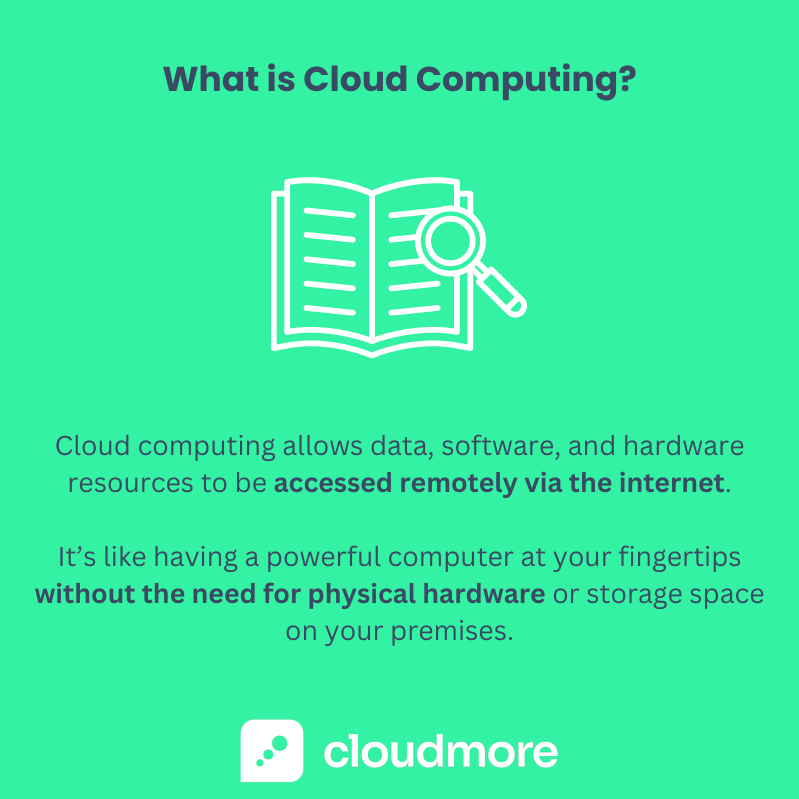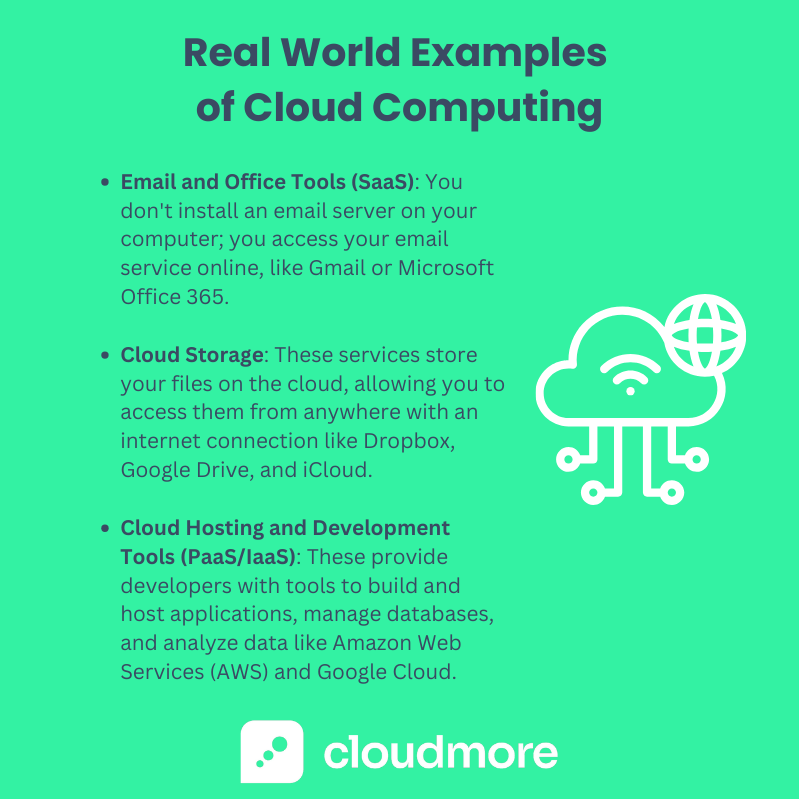What is Cloud Computing: Definition, Use Cases & Examples
Cloud computing puts data, applications, and resources just a click away, transcending the physical confines of traditional computing.
In this article, we're diving into the intricacies of cloud computing, a concept that redefines how businesses and individuals interact with technology.
We'll navigate the operational benefits and challenges, shedding light on how different industries leverage cloud computing for transformative results. Whether it's streamlining operations, enhancing data security, or offering scalable solutions, cloud computing is a game-changer.
Understanding Cloud Computing
Cloud computing has become a cornerstone for how we manage and process data. But what exactly is it? Let's demystify this technology that's reshaping our digital landscape.
Definition and Basics
So, what is cloud computing in simple terms?

Imagine having the power to access computing services over the internet rather than from your local computer or server. This is the essence of cloud computing.
It's a model where data, software, and hardware resources are provided remotely through the internet – a concept often called 'the cloud'.
Think of it as having an invisible, powerful computer at your fingertips without the need for physical hardware or storage space on your premises.
Types of Cloud Computing
Cloud computing isn't a one-size-fits-all solution. It comes in various forms, each serving different needs. Primarily, it's categorized into three types:
- Infrastructure as a Service (IaaS): This is the most flexible category of cloud services. It offers virtualized computing resources over the internet. In IaaS, you manage your applications, data, middleware, etc., while the provider manages the networks, servers, storage, and virtualization.
- Platform as a Service (PaaS): This cloud computing model provides you with hardware and software tools available over the internet. It's primarily used for application development. The provider manages the underlying infrastructure (servers, storage, network) while you focus on deploying and managing your applications.
- Software as a Service (SaaS): Perhaps the most widely known form, SaaS provides a complete software solution you purchase on a pay-as-you-go basis from a cloud service provider. You rent the use of an app for your organization, and your users connect to it over the internet, typically with a web browser.

Each type offers unique features and capabilities, providing various solutions for different business needs. Understanding these can help you decide which cloud computing model aligns best with your goals.
How Does Cloud Computing Work?
Cloud computing might seem complex at first glance. However, once you understand how it works, you'll see it's a powerful tool that simplifies data handling and computing processes.
Technical Explanation
At its core, cloud computing functions by storing and accessing data and programs over the internet instead of your computer's hard drive.
When you store files on or run programs from the hard drive, that's called local storage and computing. Everything you need is physically close to you, so accessing your data is fast and easy for that one computer or others on the local network.
With cloud computing, your data and applications are stored on servers housed in a secure, remote data center. This setup allows computing resources to be accessed and shared via the internet or dedicated networks.
Your device communicates with the cloud server when you use a cloud service. The cloud's computing power handles the load, delivering the necessary functionality. Cloud computing provides the muscle behind the scenes, whether you're updating a database, sending emails, or streaming videos.
Real-World Examples
To bring the concept to life, let's look at some everyday examples:
- Email and Office Tools (SaaS) like Gmail or Microsoft Office 365: You don't install an email server on your computer; instead, you access your email service online. These tools also simplify tasks like sending and tracking follow-up emails, ensuring timely communication and better task management.
- Cloud Storage like Dropbox, Google Drive, and iCloud: These services store your files on the cloud, allowing you to access them from anywhere with an internet connection.
- Cloud Hosting and Development Tools (PaaS/IaaS) like Amazon Web Services (AWS) and Google Cloud Platform: These provide developers with tools to build and host applications, manage databases, and analyze data.

These examples showcase how cloud computing is woven into the fabric of our digital lives, providing convenience, efficiency, and scalability.
Benefits and Challenges of Cloud Computing
Cloud computing has revolutionized businesses' operations, offering numerous benefits but presenting unique challenges. Understanding these can help you leverage cloud computing effectively.
Advantages
- Cost-Effectiveness: One of the most significant benefits of cloud computing is its cost-efficiency. It eliminates the capital expense of buying hardware and software, running data centers, and paying expert staff to manage the infrastructure. You only pay for what you use, which can lead to substantial savings.
- Scalability and Flexibility: Whether a small business or a large enterprise, cloud computing provides the flexibility to scale your IT resources up or down based on your needs. This scalability means you can access resources when needed without over-investing in hardware.
- Performance and Efficiency: Cloud services run on a network of secure data centers regularly upgraded to the latest generation of fast and efficient computing hardware. This offers several benefits over a single corporate data center, including reduced application network latency and more significant economies of scale.
Challenges and Solutions
- Security Concerns: One of the major challenges of cloud computing is ensuring data security and privacy. The fear of data breaches and losing control over sensitive information is real. However, reputable cloud providers invest heavily in security, employing various physical, operational, and software measures to protect your data.
- Compliance and Legal Issues: Navigating legal and compliance issues can be tricky, especially with data stored in countries with varying regulations. Solution? Choose cloud providers that comply with international standards and regulations, and ensure your agreement covers these aspects.
- Technical Issues and Downtime: Cloud computing isn't immune to technical glitches and downtime like any technology. To mitigate this, opt for providers with a proven track record of reliability and transparent service level agreements (SLAs) that guarantee uptime and offer compensation for any outages.
While cloud computing offers unparalleled cost, scalability, and performance advantages, it's essential to be aware of its challenges. By choosing the right provider and staying informed about security and compliance, you can maximize the benefits of cloud computing while minimizing its risks.
Use Cases in Various Industries
Cloud computing is not just a technology trend; it's a vital resource reshaping numerous industries. Here's a look at how cloud computing is revolutionizing different sectors:
- Banking and Financial Services – Cloud computing enables the banking sector to innovate in customer relationship management, quickly handle large volumes of data for faster transactions, and enhance financial data security.
- Education – Schools and universities use cloud-based platforms for digital lesson plans, remote learning, and data storage, making education more accessible and collaborative. One of the key benefits of LMS is that it streamlines communication and resource sharing among students and educators
- Healthcare – The healthcare industry is leveraging cloud computing for telehealth services, efficient patient data management, and integrating wearable technology for real-time health monitoring.
- Automotive – The automotive sector uses cloud computing to manage engineering simulations, data analytics, and dealer networks and facilitate customer service through real-time data access.
- Real Estate – Real estate companies use cloud computing for real-time data access from centralized locations, enhancing the decision-making process for agents, brokers, and contractors.
- Legal – In the legal industry, cloud computing is essential for storing large files securely and accessibly, facilitating advanced backup and recovery processes.
- Insurance – Cloud solutions in the insurance sector enable real-time collaboration and efficient customer portals, streamlining the process of managing accounts and improving customer service.
- Hospitality – The hospitality industry benefits from cloud computing through scalable solutions that improve guest experiences, such as streamlining appointment bookings and food ordering processes.
- Production and Manufacturing – Manufacturing companies use cloud computing to manage diverse locations and supply chains, providing the necessary infrastructure and cost efficiency for large-scale operations.
Each of these industries demonstrates the versatile applications of cloud computing, from enhancing customer experiences to streamlining operations and ensuring data security.
Key Takeaways about Cloud Computing
As we wrap up our journey through the cloud, let's reflect on what we've learned:
- Cloud Computing Defined: At its core, cloud computing is about accessing computing services over the internet. It's a flexible, efficient way to manage data and applications, offering a simple definition yet encompassing a vast range of services and technologies.
- Variety of Forms: From Infrastructure as a Service (IaaS) to Platform as a Service (PaaS) and Software as a Service (SaaS), cloud computing comes in several forms, each catering to different business needs. Understanding these types will help you choose the right cloud services for your goals.
- Operational Benefits: Cloud computing offers cost-effectiveness, scalability, and improved performance. It's a solution that saves money, adapts to your business growth, and delivers enhanced efficiency.
- Challenges to Navigate: While the advantages are many, challenges like security concerns, compliance issues, and potential downtime are part of the package. Tackling these involves choosing reliable providers and staying informed about best practices.
- Industry Transformations: The impact of cloud computing spans across industries – from banking and healthcare to education and entertainment. Each sector harnesses the cloud's power to innovate and improve its operations and services.
- Future Outlook: The future of cloud computing is bright and evolving. As technology advances, we can expect even more innovative uses and developments in cloud computing.
As you continue to explore the world of cloud computing, remember it's a journey of constant learning. Whether you're a beginner or looking to deepen your knowledge, there's always more to discover about how cloud computing can revolutionize our work and life.
Stay curious, stay informed, and consider how cloud computing can be a part of your digital transformation.
Share this
You May Also Like
These Related Stories

What is a Cloud Application? Definition, Pros & Cons + Examples

How Enhanced IT Procurement is Saving Organizations Millions



